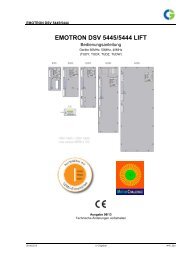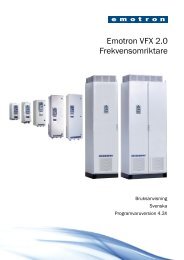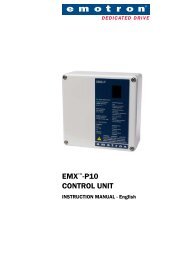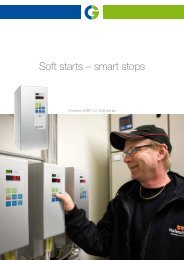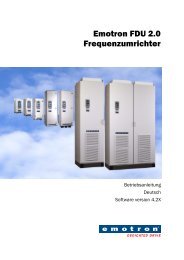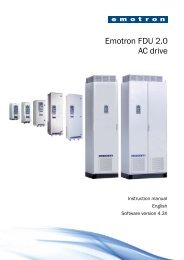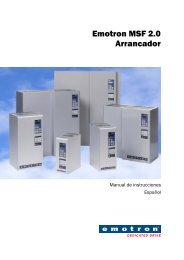Emotron MSF 2.0 Fieldbus Option
Emotron MSF 2.0 Fieldbus Option
Emotron MSF 2.0 Fieldbus Option
You also want an ePaper? Increase the reach of your titles
YUMPU automatically turns print PDFs into web optimized ePapers that Google loves.
<strong>Emotron</strong> <strong>MSF</strong> <strong>2.0</strong><br />
<strong>Fieldbus</strong> <strong>Option</strong><br />
Instruction manual<br />
English
Valid for the following models:<br />
EMOTRON <strong>Fieldbus</strong><br />
<strong>Fieldbus</strong> <strong>Option</strong><br />
Instruction Manual - English<br />
Document number: 01-5927-01<br />
Edition: r0<br />
Date of release: 2012-03-01<br />
© Copyright CG Drives & Automation Sweden AB 2012.<br />
CG Drives & Automation Sweden AB retain the right to change specifications<br />
and illustrations in the text, without prior notification. The<br />
contents of this document may not be copied without the explicit<br />
permission of CG Drives & Automation Sweden AB.
Safety<br />
Instruction manual<br />
It is important to be familiar with the softstarter to fully understand this<br />
instruction manual.<br />
Technically qualified personnel<br />
Installation, commissioning, demounting, making measurements, etc. of or on<br />
the <strong>Emotron</strong> products may only be carried out by personnel technically qualified<br />
for the task.<br />
Installation<br />
The installation must be made by authorised personnel and must be made<br />
according to the local standards.<br />
Opening the softstarter<br />
DANGER!<br />
ALWAYS SWITCH OFF THE MAINS VOLTAGE BEFORE<br />
OPENING THE UNIT.<br />
Always take adequate precautions before opening the softstarter. Although the<br />
connections for the control signals and the jumpers are isolated from the mains<br />
voltage. Always take adequate precautions before opening the softstarter.<br />
EMC Regulations<br />
EMC regulations must be followed to fulfil the EMC standards.<br />
CG Drives & Automation 01-5927-01r0<br />
Safety
Safety<br />
CG Drives & Automation 01-5927-01r0
Contents<br />
Safety ..................................................................................................... 1<br />
1. Quick Set-up................................................................................ 3<br />
2. General........................................................................................ 5<br />
2.1 Introduction................................................................................................. 5<br />
2.2 Description.................................................................................................. 5<br />
2.3 Users............................................................................................................ 5<br />
2.4 Safety........................................................................................................... 6<br />
2.5 Delivery and Unpacking.............................................................................. 6<br />
3. FieldBus I/O................................................................................ 7<br />
3.1 Introduction................................................................................................. 7<br />
3.2 HMS ............................................................................................................. 7<br />
3.3 Interfaces of communication..................................................................... 7<br />
3.4 Setting up.................................................................................................... 8<br />
3.5 Description of Jumpers and LED´s ........................................................... 8<br />
3.6 Recommendation ....................................................................................... 9<br />
4. ProfiBus - Dp ............................................................................. 11<br />
4.1 Introduction.............................................................................................. 11<br />
4.2 Setting up................................................................................................. 11<br />
5. DeviceNet.................................................................................. 13<br />
5.1 Introduction.............................................................................................. 13<br />
5.2 Setting up................................................................................................. 13<br />
6. RS-232....................................................................................... 17<br />
6.1 EmoSoftCom ............................................................................................ 17<br />
6.2 Modbus RTU and RS-232 ....................................................................... 17<br />
6.3 Modes....................................................................................................... 17<br />
6.4 RS-232 Connection ................................................................................. 18<br />
CG Drives & Automation 01-5927-01r0 1
7. <strong>Emotron</strong> <strong>MSF</strong> <strong>2.0</strong> ..................................................................... 19<br />
7.1 Response time.......................................................................................... 19<br />
7.2 Installation in <strong>Emotron</strong> <strong>MSF</strong>-017 to <strong>MSF</strong>-145 ....................................... 19<br />
7.3 Installation in <strong>Emotron</strong> <strong>MSF</strong>-170 to <strong>MSF</strong>-1400..................................... 21<br />
7.4 Set-up Communication Parameters........................................................ 24<br />
7.5 Selection of control sources .................................................................... 27<br />
7.6 Using serial comm. with <strong>Fieldbus</strong>............................................................ 28<br />
7.7 Using serial communication with RS-232 Modbus RTU ........................ 28<br />
7.8 Map ........................................................................................................... 29<br />
7.9 Getting started - simple communication example ................................. 34<br />
2 CG Drives & Automation 01-5927-01r0
1. Quick Set-up<br />
Following flowchart is a step by step guide for advanced users, with references to<br />
chapters with detailed information.<br />
Set FieldBus I/O Address<br />
- Profibus, see 4.2.3<br />
- DeviceNet, see 5.2.3<br />
Set FieldBus I/O Baudrate<br />
- Profibus, automatically selected<br />
- DeviceNet, see 5.2.4<br />
Set internal Communication Address<br />
- <strong>MSF</strong>, use address 1, see 7.4<br />
Set internal Communication Baudrate<br />
- <strong>MSF</strong>, use 19.2 kBaud, see 7.4<br />
Set Internal Communication Parity<br />
- <strong>MSF</strong>, use No Parity, see 7.4<br />
Set Control Mode<br />
- <strong>MSF</strong>, parameter 200, use mode 3,<br />
see 7.5<br />
Fig. 1<br />
Step by step guide.<br />
CG Drives & Automation 01-5927-01r0 Quick Set-up 3
4 Quick Set-up CG Drives & Automation 01-5927-01r0
2. General<br />
2.1 Introduction<br />
The FieldBus I/O interface allows external equipment to exchange data and run<br />
our products.<br />
The FieldBus I/O interface acts as a slave in a master slave configuration.<br />
Physical connection can be either RS-232 or one of the available fieldbuses.<br />
2.2 Description.<br />
This instruction manual describes the installation and operation of the FieldBus<br />
I/O option card, which can be built into the following products:<br />
<strong>MSF</strong> <strong>2.0</strong> Softstarters:<br />
<strong>MSF</strong>-017 - <strong>MSF</strong>-1400<br />
Specific information about the softstarters is in chapter 7. page 19.<br />
2.3 Users<br />
This instruction manual is intended for:<br />
• Installation engineers<br />
• Designers<br />
• Maintenance engineers<br />
• Service engineers<br />
• Programmers<br />
CG Drives & Automation 01-5927-01r0 General 5
2.4 Safety<br />
Because this option is a supplementary part of the softstarter, the user must be<br />
familiar with the original instruction manual of the <strong>MSF</strong> <strong>2.0</strong> softstarter. All<br />
safety instructions, warnings etc. as mentioned in this instruction manual are to<br />
be known to the user.<br />
The following indications can appear in this manual. Always read this first and<br />
be aware of their content before continuing.<br />
NOTE: Additional information as an aid to avoiding problems.<br />
CAUTION!<br />
Failure to follow these instructions can result in malfunction or damage to<br />
the softstarter.<br />
WARNING!<br />
Failure to follow these instructions can result in serious injury to the user in<br />
addition to serious damage to the softstarter.<br />
2.5 Delivery and Unpacking.<br />
Check for any visible signs of damage. Inform your supplier immediately of any<br />
damage found. Do not install the option card if damage is found.<br />
If the option card is moved from a cold storage room to the room where it is to<br />
be installed, condensation can form on it. Allow the option card to become fully<br />
acclimatised and wait until any visible condensation has evaporated before<br />
installing it in the softstarter.<br />
6 General CG Drives & Automation 01-5927-01r0
3. FieldBus I/O<br />
3.1 Introduction<br />
The FieldBus I/O <strong>Option</strong> consists of 2 parts. One part is an AnyBus I/O<br />
Module. This module is a third part and comes from HMS.<br />
We have chosen to buy this part because of the complexity and amount of<br />
fieldbuses.<br />
3.2 HMS<br />
This is how HMS present themselves:<br />
" HMS develops and supplies high tech electronics to quality conscious<br />
customers worldwide. HMS was one of the first companies to develop interfaces<br />
for all major fieldbus systems. Today, ten years later, we have expanded both the<br />
technology and our own skills. We are now one of the world’s leading<br />
companies in the fieldbus technology sphere, and are the global leaders in<br />
embedded OEM fieldbus modules for industrial products. "<br />
3.3 Interfaces of communication<br />
Fig. 2<br />
Ways to communicate<br />
CG Drives & Automation 01-5927-01r0 FieldBus I/O 7
3.4 Setting up<br />
Several steps must be done for a complete set-up. Both FieldBus I/O <strong>Option</strong><br />
and the softstarter must be set for a complete and working system. The FieldBus<br />
I/O <strong>Option</strong> is also divided into 2 parts; FieldBus and RS-232.<br />
3.5 Description of Jumpers and LED´s<br />
J2<br />
64 32<br />
COM.FAILURE<br />
RUN<br />
TESTMODE2<br />
TESTMODE1<br />
FIELD-<br />
BUS RS-232<br />
J1<br />
Fig. 3 Jumper 1<br />
3.5.1 Mode<br />
User can choose between RS-232 and FieldBus with jumper J1. It is not<br />
possible to communicate in both ways at the same time.<br />
8 FieldBus I/O CG Drives & Automation 01-5927-01r0
3.5.2 LED indication<br />
Four LED´s indicates what status the FieldBus I/O <strong>Option</strong> have.<br />
LED 1 and 2 are only for internal use at production.<br />
LED 3 (green) indicates that the FieldBus communication is working and<br />
running.<br />
LED 4 (red) indicates that external communication is broken.<br />
LED 3 and 4 (red and green) indicates that the FieldBus I/O <strong>Option</strong> is trying to<br />
achieve internal communication with the product. This state is seen when the<br />
product is started. If the product is not correct set the <strong>Fieldbus</strong> I/O <strong>Option</strong> will<br />
remain in this state.<br />
3.6 Recommendation<br />
We suggest that installation, cables and connectors must be followed as specified<br />
by each fieldbus organisation.<br />
CG Drives & Automation 01-5927-01r0 FieldBus I/O 9
10 FieldBus I/O CG Drives & Automation 01-5927-01r0
4. ProfiBus - Dp<br />
4.1 Introduction<br />
PROFIBUS-DP is designed for high-speed data communication at the device<br />
level. Here, central controllers (e.g., PLC’s/PC’s) communicate with their<br />
distributed field devices (I/O, drives, valves, etc.) via a high-speed serial link.<br />
Most of the data communication with these distributed devices is done in a<br />
cyclic manner. The functions required for these communications are specified<br />
by the basic PROFIBUS-DP functions in accordance with EN 50 170.<br />
4.2 Setting up<br />
Before commencing communication with the FieldBus I/O option, the option<br />
and the product will need some settings. For product settings information see<br />
the product specific chapters.<br />
4.2.1 Picture of interface<br />
Terminating resistor<br />
Connection LEDS S3 S2<br />
Address<br />
X10 X1<br />
Fig. 4<br />
Profibus interface.<br />
4.2.2 Connection<br />
Table 1<br />
9-pin D-sub connector.<br />
D-sub<br />
Description<br />
8 A-Line<br />
3 B-Line<br />
Housing<br />
Shield<br />
5 GND<br />
6 Vcc<br />
4 RTS<br />
CG Drives & Automation 01-5927-01r0 ProfiBus - Dp 11
4.2.3 Address<br />
Address can be set from 00 to 99 by rotary switches S2 and S3. To calculate the<br />
address, multiply S3’s value by 10 and then add the values.<br />
4.2.4 Baudrate<br />
The baudrate is automatically selected from 9600 Baud to 12M Baud.<br />
4.2.5 Termination<br />
Termination of the fieldbus requires a terminating resistor at each end of the<br />
fieldbus. Switching S1 to ON can connect the termination resistor.<br />
4.2.6 Led indication<br />
Table 2<br />
LED indication<br />
Led Colour Function<br />
Error Red Bus off/error<br />
DIA Green Not implemented<br />
Power Green Power on<br />
12 ProfiBus - Dp CG Drives & Automation 01-5927-01r0
5. DeviceNet<br />
5.1 Introduction<br />
DeviceNet is a low-cost communication link to connect industrial devices (such<br />
as limit switches, photo electric sensors, valve manifolds, motor starters, process<br />
sensors, bar code readers, variable frequency drives, panel displays and operator<br />
interfaces) to a network and eliminate expensive hardwiring. The direct connectivity<br />
provides improved communication between devices as well as important<br />
device-level diagnostics not easily accessible or available through hardwired I/O<br />
interfaces.<br />
Before commencing communication with the FieldBus I/O option, the option<br />
and the softstarter will need some settings. For softstarter settings information,<br />
see chapter 7. on page 19.<br />
5.2 Setting up<br />
Before commencing communication with the FieldBus I/O option, the option<br />
will need some settings.<br />
5.2.1 Picture of interface<br />
Connection LED Address BAUDRATE<br />
1 2 3 4 5<br />
Fig. 5<br />
DeviceNet interface.<br />
CG Drives & Automation 01-5927-01r0 DeviceNet 13
5.2.2 Connection<br />
Table 3<br />
Connection<br />
Screw Terminal<br />
Description<br />
1 V-<br />
2 CAN_L<br />
3 Shield<br />
4 CAN_H<br />
5 V+<br />
5.2.3 Address<br />
The first 6 switches (DIP1-6) on the DIP switch selects the address. The address<br />
setting on the DIP switch is binary coded with LSB to the left.<br />
5.2.4 Baudrate<br />
There are three different baudrates for DeviceNet; 125k, 250k and 500kbit/s.<br />
Chose one of them by setting the switches (DIP 7-8) on the DIP switch before<br />
configuring.<br />
Table 4<br />
Baudrate<br />
Baudrate (bit/s) DIP 7-8<br />
125k 00<br />
250k 10<br />
500k 01<br />
Reserved 11<br />
5.2.5 Termination<br />
Termination of the fieldbus requires a terminating resistor at each end of the<br />
fieldbus. These resistors should have a value of 121 . Connect resistor between<br />
screw terminal 2 and 4.<br />
14 DeviceNet CG Drives & Automation 01-5927-01r0
5.2.6 Led indication<br />
Table 5<br />
LED indication<br />
Led Colour Function<br />
Power Green Power on<br />
Net Status Red/Green Red flashing: Recoverable fault<br />
Red solid: Critical module fault<br />
Green flashing: On-line but not connected<br />
Green solid: On-line, link okay, connected<br />
Address Overwritten<br />
Red<br />
Power on<br />
CG Drives & Automation 01-5927-01r0 DeviceNet 15
16 DeviceNet CG Drives & Automation 01-5927-01r0
6. RS-232<br />
6.1 EmoSoftCom<br />
This connection is mainly provided for the EmoSoftCom, a PC program.<br />
EmoSoftCom is a utility that will help customers to monitor and configure the<br />
<strong>MSF</strong> <strong>2.0</strong> softstarter.<br />
Fig. 6<br />
RS-232 communication.<br />
6.2 Modbus RTU and RS-232<br />
For more information about this possibility, please see the Serial<br />
Communication <strong>Option</strong> Instruction Manual, which can be obtained from<br />
CG Drives & Automation.<br />
6.3 Modes<br />
To activate RS-232 communication mode, jumper must be in the RS-232<br />
position. When jumper is in the FieldBus mode it is not possible to<br />
communicate with RS-232 and vice versa.<br />
CG Drives & Automation 01-5927-01r0 RS-232 17
Jumper<br />
<strong>Fieldbus</strong> RS-232<br />
RS-232<br />
Fig. 7<br />
RS-232 configuration.<br />
6.4 RS-232 Connection<br />
Table 6<br />
RS-232 Connection<br />
D-sub<br />
Description<br />
2 Tx<br />
3 Rx<br />
5 GND<br />
18 RS-232 CG Drives & Automation 01-5927-01r0
7. <strong>Emotron</strong> <strong>MSF</strong> <strong>2.0</strong><br />
NOTE: This chapter explains communication with fieldbus only.<br />
7.1 Response time<br />
In normal case there is a 50-70ms response time. Due to variations in workload<br />
the response time can be up to 300ms.<br />
7.2 Installation in <strong>Emotron</strong> <strong>MSF</strong>-017 to<br />
<strong>MSF</strong>-145<br />
The following figures show the installation of the FieldBus I/O option in<br />
<strong>Emotron</strong> <strong>MSF</strong>-017 to <strong>MSF</strong>-145.<br />
Remove first the lid on the top side of the softstarter and then remove the<br />
control panel (1). Then remove the two screws and loosen the metal plate on<br />
the top (2).<br />
1 2<br />
Mount the option card according to the following pictures. Fasten the flat cable<br />
first (3) and then put the option card in position and fasten it with the screws<br />
again. Then connect the flat cable to the option card (4).<br />
CG Drives & Automation 01-5927-01r0 <strong>Emotron</strong> <strong>MSF</strong> <strong>2.0</strong> 19
3 4<br />
Put the control panel back on again (5).<br />
5<br />
20 <strong>Emotron</strong> <strong>MSF</strong> <strong>2.0</strong> CG Drives & Automation 01-5927-01r0
7.3 Installation in <strong>Emotron</strong> <strong>MSF</strong>-170 to<br />
<strong>MSF</strong>-1400<br />
The following figures show the installation of the <strong>Fieldbus</strong> I/O option in<br />
<strong>Emotron</strong> <strong>MSF</strong>-170 to <strong>MSF</strong>-1400. Follow the instructions in section 7.2, page<br />
19.<br />
CG Drives & Automation 01-5927-01r0 <strong>Emotron</strong> <strong>MSF</strong> <strong>2.0</strong> 21
22 <strong>Emotron</strong> <strong>MSF</strong> <strong>2.0</strong> CG Drives & Automation 01-5927-01r0
CG Drives & Automation 01-5927-01r0 <strong>Emotron</strong> <strong>MSF</strong> <strong>2.0</strong> 23
7.4 Set-up Communication Parameters<br />
The following parameters have to be set-up on the softstarter:<br />
• Unit address.<br />
• Baud rate.<br />
• Parity<br />
• Behaviour when contact broken.<br />
Setting up the communication parameter has to be done from the local <strong>MSF</strong><br />
<strong>2.0</strong> control panel. For this purpose the softstarter has to be in control panel<br />
mode with the control source [200] set to 1 (Control panel) or 2 (Remote<br />
control) and the paramter set [240] set to any value but 0 (External control of<br />
parameter set). See also section 7.5, page 27.<br />
24 <strong>Emotron</strong> <strong>MSF</strong> <strong>2.0</strong> CG Drives & Automation 01-5927-01r0
Serial comm. unit address [270]<br />
2 7 0<br />
Setting<br />
1<br />
Serial comm. unit address<br />
Default: 1<br />
Range: 1-247<br />
1-247 Unit address.<br />
Serial comm. baudrate [271]<br />
2 7 1<br />
Setting<br />
9. 6<br />
Serial comm. baudrate<br />
Default: 9.6 kBaud<br />
Range: 2.4 - 38.4 kBaud<br />
2.4-38.4 Baudrate.<br />
The baudrate has to be set to 19.2 kbaud for <strong>Fieldbus</strong> operation.<br />
Serial comm. parity [272].<br />
2 7 2<br />
Setting<br />
0<br />
Serial comm. parity<br />
Default: 0<br />
Range: 0, 1<br />
0 No parity<br />
1 Even parity.<br />
CG Drives & Automation 01-5927-01r0 <strong>Emotron</strong> <strong>MSF</strong> <strong>2.0</strong> 25
Serial comm. broken alarm [273]<br />
If the softstarter is configured for control via serial communications (menu<br />
[200] = 3) and the serial communication contact is broken during operation, an<br />
F15 alarm can be configured to occur. In this menu the alarm can be enabled<br />
and an action to be performed can be chosen. The following options are<br />
available:<br />
OFF<br />
Serial communication contact broken alarm is disabled.<br />
WARNING<br />
Alarm message F15 is shown in the display and relay K3 is activated (for default<br />
configuration of the relays). However, the motor is not stopped and operation<br />
continues. The alarm message will disappear and the relay will be reset when the<br />
fault disappears. The alarm may also be reset manually from the control panel.<br />
COAST<br />
Alarm message F15 is shown in the display and relay K3 is activated (for default<br />
configuration of the relays). The motor voltage is automatically switched off.<br />
The motor freewheels until it stops.<br />
STOP<br />
Alarm message F15 is shown in the display and relay K3 is activated (for default<br />
configuration of the relays). The motor is stopped according to the stop settings<br />
in menu [320] - [325].<br />
BRAKE<br />
Alarm message F15 is shown in the display and relay K3 is activated (for default<br />
configuration of the relays). The brake function is activated according to the<br />
braking method chosen in menu [323] and the motor is stopped according to<br />
the alarm brake settings in menu [326] - [327] (braking strength and braking<br />
time).<br />
A serial communication broken alarm is automatically reset when a new start<br />
signal is given. The start signal can be given via control panel, remotely or via<br />
serial communication depending on the control source chosen in menu 200.<br />
Regardless of the chosen control source, it is always possible to initiate a reset via<br />
control panel.<br />
26 <strong>Emotron</strong> <strong>MSF</strong> <strong>2.0</strong> CG Drives & Automation 01-5927-01r0
2 7 3<br />
Setting<br />
o<br />
F<br />
F<br />
Serial comm. contact broken<br />
(alarm code F15)<br />
Default: 2<br />
Range: oFF, 1, 2, 3, 4<br />
oFF<br />
Serial comm. contact broken disabled<br />
1 Warning<br />
2 Coast<br />
3 Stop<br />
4 Brake<br />
7.5 Selection of control sources<br />
Setting up the control source has to be done from the local <strong>MSF</strong> <strong>2.0</strong> control<br />
panel.<br />
2 0 0<br />
Setting<br />
2<br />
Control source<br />
Default: 2 (remote control)<br />
Range: 1, 2, 3<br />
1 Control panel.<br />
2 Remote control.<br />
3 Serial communication control.<br />
In all control sources it is possible to readout all the bit map (see 7.8)<br />
information in the softstarter via serial communication.<br />
CG Drives & Automation 01-5927-01r0 <strong>Emotron</strong> <strong>MSF</strong> <strong>2.0</strong> 27
7.6 Using serial comm. with <strong>Fieldbus</strong><br />
The source from where operation and parameter settings are made is selected in<br />
the control source parameter menu 200. When serial communication control<br />
source (menu 200=3) is selected, it is possible to:<br />
• Operate the softstarter only via serial comm.<br />
• Set-up parameters only via serial comm.<br />
• Readout all bitmap information (see 7.8).<br />
• Set-up the control source parameter from local<br />
<strong>MSF</strong> control panel.<br />
• View all parameters from local <strong>MSF</strong> control panel.<br />
7.7 Using serial communication with<br />
RS-232 Modbus RTU<br />
The source from where operation and parameter settings are made is selected in<br />
the control source parameter menu 200 (see also the Serial Communication<br />
Manual which can be obtained from <strong>Emotron</strong>). When serial communication<br />
control source (menu 200=3) is selected, it is possible to:<br />
• Operate the softstarter only via serial comm.<br />
• Set-up parameters only via serial comm.<br />
• Readout all view information and all parameters.<br />
• Set-up the control source parameter from local <strong>MSF</strong> control panel.<br />
• Inspect all parameters from local <strong>MSF</strong> control panel.<br />
28 <strong>Emotron</strong> <strong>MSF</strong> <strong>2.0</strong> CG Drives & Automation 01-5927-01r0
7.8 Map<br />
7.8.1 Definitions<br />
This is the definitions of bits and bytes.<br />
Bit<br />
Fig. 8<br />
Bytes.<br />
Explanation:<br />
0 ->1 = edge trigged function, the switch from low to<br />
high activates the function once.<br />
1 ->0 = edge trigged function, the switch from high to<br />
low activates the function once.<br />
1 = level trigged function which is active<br />
0 = level trigged function which is not active<br />
LSB (Least significant bit) has the lowest number for each function. For<br />
example: Parameter set = 1; bit 3=1, bit 4=0, bit 5=0<br />
7.8.2 Request<br />
Bit<br />
Input to<br />
<strong>MSF</strong><br />
Setting<br />
Comment<br />
<strong>MSF</strong> Manual<br />
reference<br />
0<br />
1<br />
Run /<br />
Stop<br />
Alarm<br />
Reset<br />
Run = 0 -> 1,<br />
Stop = 1 -> 0<br />
Reset = 0 ->1<br />
2 Auto Set Auto set = 0->1<br />
Sets the normal load for the load<br />
monitor.<br />
See <strong>MSF</strong> manual<br />
CG Drives & Automation 01-5927-01r0 <strong>Emotron</strong> <strong>MSF</strong> <strong>2.0</strong> 29
Bit<br />
Input to<br />
<strong>MSF</strong><br />
Setting<br />
Comment<br />
<strong>MSF</strong> Manual<br />
reference<br />
3 Parameter<br />
Set<br />
4<br />
5<br />
6<br />
7<br />
8<br />
9<br />
10<br />
11<br />
12<br />
Jog<br />
Reverse<br />
View<br />
value<br />
selection<br />
13 Not used<br />
14 Not used<br />
Jog Forward<br />
15-<br />
31<br />
Not used<br />
BIT 5 4 3<br />
Par set 0 = 0 0 0<br />
Par set 1 = 0 0 1<br />
Par set 2 = 0 1 0<br />
Par set 3 = 0 1 1<br />
Par set 4 = 1 0 0<br />
Off = 0<br />
On = 1<br />
Off = 0<br />
On = 1<br />
BIT12 11 10 9 8<br />
1 = 0 0 0 0 1<br />
2 = 0 0 0 1 0<br />
3= 0 0 0 1 1<br />
4 = 0 0 1 0 0<br />
5 = 0 0 1 0 1<br />
6 = 0 0 1 1 0<br />
7 = 0 0 1 1 1<br />
8 = 0 1 0 0 0<br />
9 = 0 1 0 0 1<br />
10=0 1 0 1 0<br />
11=0 1 0 1 1<br />
12=0 1 1 0 0<br />
13=0 1 1 0 1<br />
14=0 1 1 1 0<br />
Par set 0 = Parameter set selected<br />
via terminal 16 & 17.<br />
Only possible to use JOG function<br />
when softstarter is stopped<br />
Only possible to use JOG function<br />
when softstarter is stopped<br />
1=Current, menu [700]<br />
2=Line main voltage, [701]<br />
3=Output shaft power, [703]<br />
4=Power factor, [702]<br />
5=Shaft torque, [705]<br />
6=Current phase L1, [708]<br />
7=Current phase L2, [709]<br />
8=Current phase L3, [710]<br />
9=Line main voltage L1-L2, [711]<br />
10=Line main voltage L1-L3, [712]<br />
11=Line main voltage L2-L3, [713]<br />
12=Used thermal capacity, [715]<br />
13=Phase sequence, [714]<br />
14=Input power<br />
See <strong>MSF</strong> manual<br />
When using JOG<br />
function be sure<br />
not to overheat<br />
motor due to the<br />
decreased cooling.<br />
see <strong>MSF</strong> manual.<br />
menu [334] and<br />
[335] must be on.<br />
Will not affect<br />
selected value for<br />
analogue output<br />
(terminal 19) see<br />
<strong>MSF</strong> manual<br />
30 <strong>Emotron</strong> <strong>MSF</strong> <strong>2.0</strong> CG Drives & Automation 01-5927-01r0
7.8.3 Response<br />
Bit<br />
Output<br />
from <strong>MSF</strong><br />
Setting<br />
Comment<br />
<strong>MSF</strong> Manual<br />
reference<br />
0<br />
1<br />
2<br />
Running/<br />
Stopped<br />
Max prealarm<br />
status<br />
Min prealarm<br />
status<br />
3 Actual<br />
Parameter<br />
Set<br />
4<br />
5<br />
6 Operation<br />
mode<br />
7<br />
8<br />
9 Operation<br />
status<br />
10<br />
11<br />
12<br />
Running = 1,<br />
Stopped = 0<br />
Pre-alarm = 1<br />
no pre-alarm =0<br />
Pre-alarm = 1<br />
no pre-alarm=0<br />
BIT 5 4 3<br />
Par set 1 = 0 0 1<br />
Par set 2 = 0 1 0<br />
Par set 3 = 0 1 1<br />
Par set 4 = 1 0 0<br />
BIT 8 7 6<br />
1 = 0 0 1<br />
2 = 0 1 0<br />
3= 0 1 1<br />
4 = 1 0 0<br />
5 = 1 0 1<br />
6 = 1 1 0<br />
7 = 1 1 1<br />
BIT 12 11 10 9<br />
1 = 0 0 0 1<br />
2 = 0 0 1 0<br />
3= 0 0 1 1<br />
4 = 0 1 0 0<br />
5 = 0 1 0 1<br />
6 = 0 1 1 0<br />
7 = 0 1 1 1<br />
8 = 1 0 0 0<br />
9 = 1 0 0 1<br />
10 = 1 0 1 0<br />
11 = 1 0 1 1<br />
12 = 1 1 0000<br />
1 = Voltage control<br />
2 = Torque control<br />
3 = Current limit control<br />
4 = Voltage control with current<br />
limit<br />
5 = Torque control with current<br />
limit<br />
7 = Direct On-line<br />
1 = Stopped<br />
2 = Stopped with alarm condition<br />
3 = Run with alarm condition<br />
4 = Run acceleration<br />
5 = Run full voltage<br />
6 = Run deceleration<br />
7 = Run bypassed<br />
8 = Run power factor control<br />
9 = Brake<br />
10 = Run at slow speed forward<br />
11 = Run at slow speed reverse<br />
12= Standby (Waiting for analogue<br />
start/stop or autoreset)<br />
See <strong>MSF</strong> manual<br />
See <strong>MSF</strong> manual<br />
See <strong>MSF</strong> manual<br />
See <strong>MSF</strong> manual<br />
CG Drives & Automation 01-5927-01r0 <strong>Emotron</strong> <strong>MSF</strong> <strong>2.0</strong> 31
Bit<br />
Output<br />
from <strong>MSF</strong><br />
Setting<br />
Comment<br />
<strong>MSF</strong> Manual<br />
reference<br />
13 control<br />
source<br />
14 Autset<br />
status<br />
15 Alarm<br />
16 status<br />
17<br />
18<br />
19<br />
Serial comm. not<br />
active=0<br />
Serial comm.<br />
active=1<br />
Ready for new<br />
Autoset=0<br />
New Autoset level<br />
OK=1<br />
BIT 1918171615<br />
0 = 0 0 0 0 0<br />
F1 = 0 0 0 0 1<br />
F2 = 0 0 0 1 0<br />
F3= 0 0 0 1 1<br />
F4 = 0 0 1 0 0<br />
F5 = 0 0 1 0 1<br />
F6 = 0 0 1 1 0<br />
F7 = 0 0 1 1 1<br />
F8 = 0 1 0 0 0<br />
F9 = 0 1 0 0 1<br />
F10=0 1 0 1 0<br />
F11=0 1 0 1 1<br />
F12=0 1 1 0 0<br />
F13=0 1 1 0 1<br />
F14=0 1 1 1 0<br />
F15=0 1 1 1 1<br />
F16=1 0 0 0 0<br />
F17=1 0 0 0 1<br />
The Autoset status switch to low when<br />
input pin 2 is low.<br />
0 = No alarm<br />
F1 = Phase input failure<br />
F2 = Motor protection<br />
F3 = Softstarter overheated<br />
F4 = Current limit start time expired<br />
F5 = Locked rotor<br />
F6 = Max power alarm<br />
F7 = Min power alarm<br />
F8 = Voltage unbalance<br />
F9 = Over voltage<br />
F10 = Under voltage<br />
F11 = Starts limitation<br />
F12 = Shorted thyristor<br />
F13 = Open thyristor<br />
F14 = Motor terminal open<br />
F15 = Serial com. broken<br />
F16 = Phase reversal alarm<br />
F17 = External alarm<br />
See <strong>MSF</strong> manual<br />
32 <strong>Emotron</strong> <strong>MSF</strong> <strong>2.0</strong> CG Drives & Automation 01-5927-01r0
Bit<br />
Output<br />
from <strong>MSF</strong><br />
Setting<br />
Comment<br />
<strong>MSF</strong> Manual<br />
reference<br />
20<br />
21<br />
22<br />
23<br />
24<br />
25<br />
26<br />
27<br />
28<br />
29<br />
30<br />
31<br />
View value<br />
View value<br />
between<br />
0 - 4000<br />
FULL RANGE<br />
1 = Current, 5 X In [A], In set in<br />
menu [211]<br />
2= Line main 1,5 X Un[V],Un set<br />
voltage, in menu [210]<br />
3= Output shaft 1,5 X Pn [KW],<br />
power, set in menu [212]<br />
4= Power factor, 1.0<br />
5= Shaft torque, 2,5 x Tn<br />
6= Current phase 5 X In [A], In set<br />
L1, in menu [211]<br />
7= Current phase 5 X In [A], In set<br />
L2, in menu [211]<br />
8= Current phase 5 X In [A], In set<br />
L3, in menu [211]<br />
9= Line main, 1,5 X Un[V],Un<br />
voltage L1-L2, set in menu [210]<br />
10= Line main 1,5 X Un [V], Un<br />
voltage L1-L3, set in menu [210]<br />
11=Line main 1,5 X Un [V], Un<br />
voltage L2-L3, set in menu [210]<br />
12=Used thermal 150 %<br />
capacity,<br />
13=Phase seq., 1=321,2=123<br />
14=Input power,<br />
1,5 X Pn [kW or<br />
hp], Pn set in<br />
menu [212]<br />
Pn<br />
Tn= ---------------------<br />
(Nn*2*pi)/60<br />
Nn [rpm], set<br />
value in menu<br />
[213]<br />
CG Drives & Automation 01-5927-01r0 <strong>Emotron</strong> <strong>MSF</strong> <strong>2.0</strong> 33
7.9 Getting started - simple communication<br />
example<br />
To obtain a connection to the <strong>MSF</strong> softstarter follow Quick Set-up in chapter 1.<br />
page 3 step by step. This example shows how to select a Parameter Set, select<br />
current as view value and to make a start.<br />
• Set bit 4=1 to select Parameter Set 2, set all other bits to 0.<br />
• Set bit 8=1 to select Current as view value.<br />
• Set bit 0=1 to make a start.<br />
The Bit Map in to <strong>MSF</strong> is now complete.<br />
If everything went ok in the softstarter, the response in ‘Pins Out <strong>MSF</strong>’ will be<br />
as follows;<br />
• Bit 0=1 Softstarter is running<br />
• Bit 1-2=0, No Pre-alarms<br />
• Bit 3=0, bit 4=1, bit 5=0, Actual Parameter Set is 2.<br />
• Bit 6=0, bit 7=1, bit 8=0, default torque control.<br />
• Bit 9=1, bit 10=0, bit 11=1, bit 12=0, Run acceleration.<br />
• Bit 13=1, Serial comm. control source.<br />
• Bit 14=0, No Auto Set.<br />
• Bit 15-19=0, No alarm.<br />
• Bit 31-20=00101000000=640, if nominal current is 17 A the actual current<br />
is 640/4000x5x17=13.6 A<br />
34 <strong>Emotron</strong> <strong>MSF</strong> <strong>2.0</strong> CG Drives & Automation 01-5927-01r0
CG Drives & Automation Sweden AB<br />
Mörsaregatan 12<br />
Box 222 25<br />
SE-250 24 Helsingborg<br />
Sweden<br />
T +46 42 16 99 00<br />
F +46 42 16 99 49<br />
www.cgglobal.com / www.emotron.com<br />
CG Drives & Automation, 01-5927-01r0, 2012-03-01



